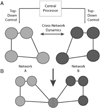Is neuroenhancement by noninvasive brain stimulation a net zero-sum proposition?
- PMID: 23880500
- PMCID: PMC4392930
- DOI: 10.1016/j.neuroimage.2013.07.038
Is neuroenhancement by noninvasive brain stimulation a net zero-sum proposition?
Abstract
In the past several years, the number of studies investigating enhancement of cognitive functions through noninvasive brain stimulation (NBS) has increased considerably. NBS techniques, such as transcranial magnetic stimulation and transcranial current stimulation, seem capable of enhancing cognitive functions in patients and in healthy humans, particularly when combined with other interventions, including pharmacologic, behavioral and cognitive therapies. The "net zero-sum model", based on the assumption that brain resources are subjected to the physical principle of conservation of energy, is one of the theoretical frameworks proposed to account for such enhancement of function and its potential cost. We argue that to guide future neuroenhancement studies, the net-zero sum concept is helpful, but only if its limits are tightly defined.
© 2013 Elsevier Inc. All rights reserved.
Conflict of interest statement
Conflict of interest statement
The authors declare that this article was written in the absence of any commercial, financial, or personal relationships that could be construed as a potential conflict of interest.
Figures






Similar articles
-
Effects of transcranial electrical stimulation on cognition.Clin EEG Neurosci. 2012 Jul;43(3):192-9. doi: 10.1177/1550059412444975. Clin EEG Neurosci. 2012. PMID: 22956647 Review.
-
Battery powered thought: enhancement of attention, learning, and memory in healthy adults using transcranial direct current stimulation.Neuroimage. 2014 Jan 15;85 Pt 3:895-908. doi: 10.1016/j.neuroimage.2013.07.083. Epub 2013 Aug 8. Neuroimage. 2014. PMID: 23933040 Review.
-
Rethinking the thinking cap: ethics of neural enhancement using noninvasive brain stimulation.Neurology. 2011 Jan 11;76(2):187-93. doi: 10.1212/WNL.0b013e318205d50d. Neurology. 2011. PMID: 21220723 Free PMC article. Review.
-
Brain power.Nature. 2016 Mar 3;531(7592):8. doi: 10.1038/531008a. Nature. 2016. PMID: 26935660 No abstract available.
-
Enhancement of human cognitive performance using transcranial magnetic stimulation (TMS).Neuroimage. 2014 Jan 15;85 Pt 3(0 3):961-70. doi: 10.1016/j.neuroimage.2013.06.007. Epub 2013 Jun 13. Neuroimage. 2014. PMID: 23770409 Free PMC article. Review.
Cited by
-
Brain stimulation for treatment and enhancement in children: an ethical analysis.Front Hum Neurosci. 2014 Dec 18;8:953. doi: 10.3389/fnhum.2014.00953. eCollection 2014. Front Hum Neurosci. 2014. PMID: 25566011 Free PMC article.
-
Noninvasive Brain Stimulation in Pediatric Attention-Deficit Hyperactivity Disorder (ADHD): A Review.J Child Neurol. 2016 May;31(6):784-96. doi: 10.1177/0883073815615672. Epub 2015 Dec 10. J Child Neurol. 2016. PMID: 26661481 Free PMC article. Review.
-
Not all brains are created equal: the relevance of individual differences in responsiveness to transcranial electrical stimulation.Front Syst Neurosci. 2014 Feb 24;8:25. doi: 10.3389/fnsys.2014.00025. eCollection 2014. Front Syst Neurosci. 2014. PMID: 24605090 Free PMC article. Review.
-
tDCS for Memory Enhancement: Analysis of the Speculative Aspects of Ethical Issues.Front Hum Neurosci. 2017 Jan 11;10:678. doi: 10.3389/fnhum.2016.00678. eCollection 2016. Front Hum Neurosci. 2017. PMID: 28123362 Free PMC article.
-
A Critical Review of Cranial Electrotherapy Stimulation for Neuromodulation in Clinical and Non-clinical Samples.Front Hum Neurosci. 2021 Feb 1;15:625321. doi: 10.3389/fnhum.2021.625321. eCollection 2021. Front Hum Neurosci. 2021. PMID: 33597854 Free PMC article. Review.
References
-
- Baddeley AD. The capacity for generating information by randomization. Q. J. Exp. Psychol. 1966;18:119–129. - PubMed
-
- Bartolomeo P. Visual neglect. Curr. Opin. Neurol. 2007;20:381–386. - PubMed
-
- Bartolomeo P, Thiebaut de Schotten M, Doricchi F. Left unilateral neglect as a disconnection syndrome. Cereb. Cortex. 2007;17:2479–2490. - PubMed
-
- Berryhill ME, Jones KT. tDCS selectively improves working memory in older adults with more education. Neurosci. Lett. 2012;521:148–151. - PubMed
-
- Biswal BB, Yetkin FZ, Haughton VM, Hyde JS. Functional connectivity in the motor cortex of resting human brain using echo-planar. MRI. Magn. Reson. Med. 1995;34:537–541. - PubMed
Publication types
MeSH terms
Grants and funding
LinkOut - more resources
Full Text Sources
Other Literature Sources
Research Materials
Miscellaneous

